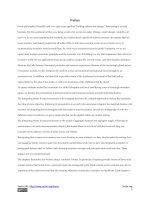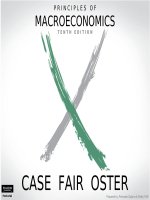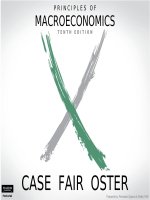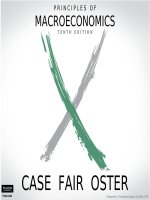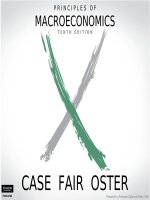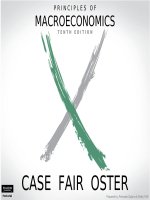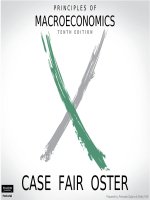Principles of macroeconomics
Bạn đang xem bản rút gọn của tài liệu. Xem và tải ngay bản đầy đủ của tài liệu tại đây (2.81 MB, 201 trang )
Principles of
Macroeconomics
Module Guide
K CHANDRA SAKARAN
Table of Contents
Chapter 1 Measuring the Size of the Economy ............................................................................................ 7
Learning Outcomes ....................................................................................................................................... 7
Introduction ................................................................................................................................................... 8
Gross Domestic Product(GDP) ................................................................................................................... 10
Computing the Real GDP and Nominal GDP ............................................................................................. 10
GDP deflator and the inflation rate ............................................................................................................. 15
Real GDP and Nominal GDP Growth Rate ................................................................................................ 16
Real GDP Per Capita .................................................................................................................................. 17
Other Ways to Measure the Economy ........................................................................................................ 17
Gross National Product(GNP) ................................................................................................................ 17
Net National Product(NNP) .................................................................................................................... 17
National Income at Factor Cost(NI)........................................................................................................ 18
What are Counted in the GDP and Not Included in the GDP .................................................................... 19
The Importance of Measuring GDP ............................................................................................................ 19
Limitations of GDP as a measure of living standards ................................................................................. 21
Chapter 2 Cost of Living........................................................................................................................... 23
Learning Outcomes ..................................................................................................................................... 23
Introduction ................................................................................................................................................. 23
Measuring the Cost of Living ..................................................................................................................... 24
Cost of Basket ......................................................................................................................................... 24
Consumer Price Index(CPI) .................................................................................................................... 25
Computing CPI ....................................................................................................................................... 25
Inflation Rate .......................................................................................................................................... 25
Limitations of CPI as a Measure of Cost of Living .................................................................................... 26
CPI and GDP Deflator ............................................................................................................................... 27
CPI versus GDP deflator ............................................................................................................................. 27
Correcting Economic Variables for the Effects of Inflation ....................................................................... 28
The Importance of CPI................................................................................................................................ 29
Real interest rate ......................................................................................................................................... 30
Indexation ................................................................................................................................................... 30
Chapter 3 Production and Growth ............................................................................................................ 31
1
Learning Outcomes ..................................................................................................................................... 31
Introduction ................................................................................................................................................. 31
GDP Purchasing Power per capita(PPP) and economic growth rate between countries. ........................... 31
Productivity and Living Standards .............................................................................................................. 32
The Production Function............................................................................................................................. 33
The Diminishing Marginal Returns ............................................................................................................ 34
Economic Growth and Public Policy .......................................................................................................... 34
Saving, Investment, and Economic Growth............................................................................................ 35
Research and Development And Economic Growth .............................................................................. 36
Trade and Economic Growth .................................................................................................................. 36
Health, Nutrition and Economic Growth ................................................................................................ 37
Education and Economic Growth ........................................................................................................... 37
Chapter 4 Saving, Investment, and Financial System ............................................................................... 38
Learning Outcomes ..................................................................................................................................... 38
Introduction ................................................................................................................................................. 38
Financial Market ......................................................................................................................................... 39
The Bond Markets (Public debt securities and Private debt securities) ...................................................... 39
The Banking System ................................................................................................................................... 39
Non-Bank Financial Intermediaries ............................................................................................................ 40
Loanable Fund Market ................................................................................................................................ 40
The supply of loanable = Saving ............................................................................................................ 40
Saving and Investment ............................................................................................................................ 42
The Supply of Loanable Fund Curve ...................................................................................................... 43
Demand for Loanable Fund .................................................................................................................... 45
Other Factors Influencing the Demand for Loanable Funds ....................................................................... 47
Changes in future expected profits or business activities ....................................................................... 47
Changes in government budget from surplus to deficit .......................................................................... 48
Change in the tax .................................................................................................................................... 48
The Market of Loanable Fund: Equilibrium and Change in the Equilibrium ............................................. 48
The Market of Loanable Fund: Equilibrium ........................................................................................... 48
The market of Loanable Fund: Change in the Equilibrium .................................................................... 50
The Loanable Funds Model .................................................................................................................... 53
2
Chapter 5 Monetary System...................................................................................................................... 54
Learning Outcomes ..................................................................................................................................... 54
Introduction ................................................................................................................................................. 54
Money and the Functions of Money ........................................................................................................... 54
Types of Money .......................................................................................................................................... 55
Central Bank ............................................................................................................................................... 56
Money Supply(MS) .................................................................................................................................... 57
Commercial Banks ...................................................................................................................................... 59
Providing Loans ...................................................................................................................................... 60
Credit Creation Process........................................................................................................................... 60
Central Bank Control the Growth of Money Supply .................................................................................. 62
Monetary Tool: Reserve Requirements .................................................................................................. 62
Monetary Tool : Discount Rate............................................................................................................... 62
Monetary Tool : Open Market Operations .............................................................................................. 63
Problems Controlling Money Supply ..................................................................................................... 64
Chapter 6
Money Growth and Inflation ................................................................................................. 65
Learning Outcomes ..................................................................................................................................... 65
Introduction ................................................................................................................................................. 65
The Classical Theory of Inflation ............................................................................................................... 66
Determinants of the Price Level.................................................................................................................. 67
Changes in the price level are caused by two factors: ............................................................................ 67
Changes in the Money Market: Changes in the Money Supply.......................................................... 67
Money Market Equilibrium ........................................................................................................................ 68
Money Demand (MD)............................................................................................................................. 68
Money Demand Shifters ..................................................................................................................... 70
Supply of Money (MS) ........................................................................................................................... 70
Money Market Equilibrium: Determination of the Real Rate of Interest ............................................... 71
Change in the Money Market Equilibrium: Monetary Injection......................................................... 72
The Effect of Monetary Injection on the Price and the Value of Money .................................................... 72
Classical Dichotomy and Monetary Neutrality ........................................................................................... 73
The quantity of Money Theory (Fisher Theory) ......................................................................................... 74
Velocity ................................................................................................................................................... 74
3
The Effect of Monetary Expansion in The long-run ............................................................................... 76
Inflation Tax............................................................................................................................................ 77
Fisher Effect ............................................................................................................................................ 77
The Cost of Inflation ................................................................................................................................... 77
Menu Costs ............................................................................................................................................. 78
Shoe leather Costs ................................................................................................................................... 78
Misallocation of Resources ..................................................................................................................... 78
Wealth Redistribution ............................................................................................................................. 79
Tax Distortions........................................................................................................................................ 79
General Inconvenience............................................................................................................................ 79
Chapter 7
Unemployment ........................................................................................................................ 80
Learning Outcomes ..................................................................................................................................... 80
Introduction ................................................................................................................................................. 80
Computing Unemployment ......................................................................................................................... 81
Labor Force Participation ........................................................................................................................... 83
Types of Unemployment............................................................................................................................. 84
Cyclical Unemployment ......................................................................................................................... 84
Remedial Action ................................................................................................................................. 85
Natural Unemployment ........................................................................................................................... 86
Frictional Unemployment ................................................................................................................... 87
Remedial Action ................................................................................................................................. 87
Structural Unemployment ....................................................................................................................... 88
Remedial Action ................................................................................................................................. 88
Minimum Wage .................................................................................................................................. 89
Unionized and Non Unionized Labor Market..................................................................................... 89
Efficiency Wage Theory ..................................................................................................................... 91
Chapter 8
Open Economy Model (Macroeconomics) ............................................................................ 93
Learning Outcomes ..................................................................................................................................... 93
Introduction ................................................................................................................................................. 93
Net Export (NX) ......................................................................................................................................... 94
The Factors Affecting Exports and Imports ............................................................................................ 95
Financial Resources .................................................................................................................................... 96
4
The Relationship Between NX and NCO ................................................................................................... 97
Nominal Exchange Rates ............................................................................................................................ 99
Nominal exchange rate versus Real exchange rate ..................................................................................... 99
Purchasing Power Parity (PPP) ................................................................................................................. 100
Implication of PPP ................................................................................................................................ 101
Limitations of Purchasing-Power Parity ............................................................................................... 102
Fixed versus Flexible exchange rates........................................................................................................ 103
Loanable Fund Market: Open Economy ................................................................................................... 103
The Market For Loanable Funds............................................................................................................... 103
The Market For Foreign Currency Exchange ........................................................................................... 105
Net capital outflow.................................................................................................................................... 106
The equilibrium......................................................................................................................................... 106
The Impact of a Specific Event on the Major Macroeconomics variables ............................................... 107
Event 1 :Government budget deficit ..................................................................................................... 107
Event 2 : Trade policy ........................................................................................................................... 108
Event 3 Political instability and Capital Flight .................................................................................... 109
Event 4 :A decrease in the national saving ........................................................................................... 110
Topic 9 : Expenditure Multiplier .............................................................................................................. 113
Learning outcomes ................................................................................................................................ 113
Aggregate Planned Expenditure(AE).................................................................................................... 113
Household consumption expenditure(C) .............................................................................................. 113
Business Investment (I) ......................................................................................................................... 115
Government Spending(G) ..................................................................................................................... 115
Export and Import ................................................................................................................................. 115
Determination of Equilibrium Real GDP in a 2-Sector Economy ........................................................ 117
Components of AE................................................................................................................................ 120
Aggregate Planned Expenditure............................................................................................................ 124
Determination of Equilibrium Real GDP in 3-SECTOR ECONOMY ................................................. 131
Determination of Equilibrium Real GDP in a 4-Sector Economy ........................................................ 137
Determination of equilibrium real GDP................................................................................................ 137
Change in the Equilibrium Real GDP ................................................................................................... 140
Equilibrium Real GDP and the Potential of full employment real GDP .............................................. 141
5
Price and Aggregate Planned Expenditure............................................................................................ 143
Chapter 10 Aggregate Demand(AD) and Aggregate Supply(AS) ......................................................... 144
Learning Outcomes ................................................................................................................................... 144
Aggregate Demand(AD) ........................................................................................................................... 144
Aggregate Demand: A Downward Sloping Curve................................................................................ 145
Wealth or Real Income Effect ........................................................................................................... 145
Interest Rate Effect ........................................................................................................................... 145
Exchange Rate Effect ........................................................................................................................ 146
Other Factors/Determinants of AD: The Shifters ................................................................................. 147
A change in consumption.................................................................................................................. 148
Changes in Investment ...................................................................................................................... 150
Changes in Government Purchases ................................................................................................... 151
Changes in the Net Exports............................................................................................................... 151
Short-run Aggregate Supply (SRAS) ........................................................................................................ 154
Deriving the SRAS and LRAS Curves ................................................................................................. 155
The Impact of an Increase in the Expected Price on the SRAS ............................................................ 157
Short-run Aggregate Supply(SRAS) – Shifters .................................................................................... 158
Long-run Aggregate Supply(LRAS) – Shifters .................................................................................... 159
Short-run and long-run equilibrium : Numerical Example 1 .................................................................... 161
Short-run and long-run equilibrium: Numerical Example 2 ..................................................................... 162
Short-run and Long-run Equilibrium: A Static Model.............................................................................. 163
Event: Households Confidence Level Increases ................................................................................... 164
Event: An Increase in the crude oil price .............................................................................................. 165
Event: Depreciation of a Currency....................................................................................................... 167
Event: An Economy is currently experiencing a recession ................................................................... 169
The Impact of Demand Policy in The Long-run Equilibrium................................................................... 171
Chapter 11 The Demand Management Policies and The Aggregate Demand ....................................... 173
Learning Outcomes ................................................................................................................................... 173
The Theory of Liquidity Preference.......................................................................................................... 173
Liquidity for Transactions motive(LT) .................................................................................................. 173
Precautionary motive ............................................................................................................................ 174
Speculative motive ................................................................................................................................ 174
6
Demand for Money Schedule ............................................................................................................... 175
Determination of the Rate of Interest ........................................................................................................ 177
Change in the Money Market Equilibrium: Monetary Injection........................................................... 178
The Effect of a Change in the Price Level on the Money Demand and Interest Rate .......................... 179
Money Supply and Aggregate Demand .................................................................................................... 180
Fiscal Policy and Aggregate Demand ....................................................................................................... 181
Changes in Government Spending........................................................................................................ 182
Changes in Taxes .................................................................................................................................. 182
Stabilization Policy – Demand Management Policy................................................................................. 184
The Short-run Effect of an Expansionary Monetary Policy.................................................................. 186
Automatic Stabilizer ................................................................................................................................. 187
Chapter 12 Unemployment and Inflation Trade-off ............................................................................... 188
Learning Outcomes ................................................................................................................................... 188
Introduction ............................................................................................................................................... 188
Short-run Phillips Curve ........................................................................................................................... 188
Derive A Short-run Phillips Curve........................................................................................................ 189
Shifts in the Short-run Phillips Curve – The Importance of Price Expectation .................................... 191
Deriving the Short-run Phillips Curve and Long-run Phillips Curve ................................................... 193
The Impact of an Increase in the Expected Inflation on the SRPC ....................................................... 194
The Other Shifters of the Short-run Phillips Curve – The Supply Shock ............................................. 195
The Cost of Disinflation............................................................................................................................ 197
Adaptive expectations (Imperfection) ....................................................................................................... 198
Adaptive expectations and Monetarist view of Phillips curve .......................................................... 198
Rational expectations (Perfection) ............................................................................................................ 199
Chapter 1 Measuring the Size of the Economy
Learning Outcomes
At the end of this topic, you are able to
7
define the gross domestic product(GDP) and also compute GDP.
explain the three approaches to computing the GDP.
distinguish between Real GDP and Nominal GDP.
compute GDP deflator and inflation rate.
compute the Real GDP and Nominal GDP growth rate.
compute the real GDP per capita and explain its importance.
distinguish between gross domestic product, gross national product(GNP), and net national
product(NNP).
explain the importance of measuring GDP.
identify and discuss the limitations of GDP as a measure of living standards and quality of
life.
Introduction
The economic performance of a country is measured to assess the achievement of the set
economic objectives. The economic objectives can be long and medium terms, such as economic
growth and development, whilst the short-term objective is more towards achieving economic
stabilization by responding to unexpected events or shock.
One of the main economic indicators to measure the economic performance is the calculation of
national income. The national income of a country can be measured using the output,
expenditure or income method.
The national income (output method) is the total value of final goods and services produced by
the various economic sectors in a given time period. It is important to ensure that double
counting is avoided. This can be done by taking the value of final goods and services. The value
of intermediate goods should be excluded. Alternatively, double counting can be avoided by
totaling valued added of the goods in an industry. Value added is obtained by deducting the
expenditure incurred on intermediate goods such as raw materials produced by an industry. For
example, the car industry purchased various forms of raw materials worth $10 million and
produced cars worth $18 million. The national income is $18million, that is the value of the final
goods or it can be obtained by totaling the value added at various stages of production. The total
value added is equal to $10 million plus $8 million, which is equal to $18 million.
8
GDP (Output based) = The total market values of final goods and services
The income method is the calculation of national income by summing up all the incomes
received by the factors contributing to the production activity. Income is received by the factors
can be in the formed of wages (labor services), rent (land), interest (capital) and
profits(entrepreneurs). Transfer payments are payment received without any production
contribution. It is excluded in the calculation of national in order to avoid double counting.
Examples of transfer payments are the unemployment benefits, scholarships, given by the
government to the recipients without any productive contribution from the recipients.
GDP (Income based) = Compensation of employees + Net interest + Rental income+ Corporate
profits + Proprietors’ income
Compensation of employees is wages and salaries paid to workers for their labor services. Net
interest is the interest households receive on loans they make less the interest households pay on
their own borrowing. Where else rental income is the payment for the use of land and other
rented resources. As for the corporate profits, it involves distributed profit (dividends) and
undistributed profits or retained profit. Finally, proprietor’s income is the income earned by the
owner-operator of a business, which includes compensation for the owner’s labor service, the
usage of the owner’s capital, and profit.
Finally, we could also calculate the national income using the expenditure approach. The
expenditure approach requires the summation of expenditure of the households, firms,
government and the external sector. The household consumption of the goods and services,
investment expenditure on capital goods by the firms, government expenditure and the net export
expenditure are the four components of expenditures.
GDP (Expenditure based) = Household consumption (C) + Investment (I) + Government
expenditure(G) + [Export(X) – Import(M)]
GDP (Expenditure based) = C + I + G + NX
9
Gross Domestic Product(GDP)
The gross domestic product represents the size of a nation’s overall economy. It is defined as the
total market value of final goods and service produced within a country in a given time period.
Final goods refer to goods that cannot be transformed into any other form. It includes consumer
goods, such as handphones, fruit juices, shirts, shoes etc, and also capital goods, such as
machines, vehicles, etc. The GDP is obtained by taking the quantity of everything produced,
multiply it by the price at which each product sold, and add up the total.
The market value of final goods and services can be determined using the base year
price(constant price) or current price of the goods and services. The GDP calculated using the
base year price or constant price is known as the real GDP. Where else, the GDP calculated at
the current price is known as nominal GDP.
Computing the Real GDP and Nominal GDP
The table contains hypothetical data of a nation. It provides the prices of goods and services and
the quantity of the goods and services produced in 2013 and 2014. Taking 2013 as the base year.
Goods and
2013
2013
Price per unit
Quantity
Haircuts
$10
20
$12
24
Handbags
$50
10
$60
12
Magazines
$5
40
$6
50
Services
2014 Price per
unit
Nominal GDP(2013) = ($ 10 x 20) +($50 x 10) + ($5 x 40) = $900
Real GDP (2013) = ($ 10 x 20) +($50 x 10) + ($5 x 40) = $900
Nominal GDP (2014) = ($12 x 24) + ( $60 x 12) + (6 x 50) = $1,308
10
2014
Quantity
Real GDP (2014) = ($ 10 x 24) +($50 x 12) + ($5 x 50) = $1,090
The nominal GDP(NGDP) and the real GDP(RGDP) in the base year are the same. The NGDP
and RGDP in the base year is $900. The nominal GDP and real GDP for 2014 are different. The
real GDP for 2014 is $1,090 and the nominal GDP is $1,308. The variation is because the real
GDP is soley determined by the change in the quantity of the goods and services produced,
whilst the nominal GDP is influenced by the change in the price and quantity. As such, real
GDP is a better indicator of economic performance because the changes to the real GDP is
totally because of changes to the production.
GDP by Kind of Economic Activity at Current Prices, 2012, Malaysia
Economic Activity
Ringgit(Million)
Agriculture, livestock, forestry, and fishery
95,122
Mining and quarrying
101,474
11
Manufacturing
224,730
Construction
37,909
Utilities
25,699
Wholesale and retail trade, accommodation, food and beverages
161,393
Transport, storage, information and communication
79,620
Finance, insurance, real estates and business services
108,044
Other services
41,514
Government services
85,560
Less: Financial Intermediation Services Indirectly Measured(FISIM)
-
Plus: Import Duties
10,186
GDP at purchasers’ prices
971,252
(Source: www.statistics.gov.my)
GDP by Kind of Economic Activity at Constant Prices(the Base year 2010), 2012, Malaysia
Economic Activity
Ringgit(Million)
Agriculture, livestock, forestry, and fishery
89,406
12
Mining and quarrying
86,751
Manufacturing
211,921
Construction
34,880
Utilities
24,169
Wholesale and retail trade, accommodation, food and beverages
150,407
Transport, storage, information and communication
78,274
Finance, insurance, real estates and business services
107,715
Other services
40,337
Government services
78,397
Less: Financial Intermediation Services Indirectly Measured(FISIM)
-
Plus: Import Duties
10,004
GDP at purchasers’ prices
912,261
(Source: www.statistics.gov.my)
GDP by Type of Expenditure at Current Prices, 2012
Type of Expenditure
Ringgit(Million)
13
Government expenditure
134,442
Private expenditure
482,238
Changes in inventories
3,741
Gross fixed capital formation(Investment)
246,343
Export of goods and services
770,202
Import of goods and services
665,71
GDP at purchasers’ prices
971,252
GDP by Type of Expenditure at Constant Prices(the Base year 2010), 2012
Type of Expenditure
Ringgit(Million)
Government expenditure
124,390
Private expenditure
457,625
Changes in inventories
4,289
Gross fixed capital formation(Investment)
233,203
Export of goods and services
730,961
Import of goods and services
638,206
GDP at purchasers’ prices
912,261
14
GDP deflator and the inflation rate
It is important to be able to measure the relationship between nominal GDP (aggregate output
measured at current prices) and real GDP (aggregate output measured at constant base year
prices). This is done by measuring the GDP deflator.
The GDP deflator is a measure of price inflation. It is calculated by dividing Nominal GDP by
Real GDP and then multiplying by 100.
GDP deflator (Year 1) =
Nominal GDP(Year1)
Real GDP (Year 1)
x100
The table below provides the prices of goods and services and the quantity of the goods and
services produced in 2013 and 2014. Taking 2013 as the base year.
Goods and
2013
2013
Price per unit
Quantity
Haircuts
$10
20
$12
24
Handbags
$50
10
$60
12
Magazines
$5
40
$6
50
Services
2014 Price per
unit
Nominal GDP(2013) = ($ 10 x 20) +($50 x 10) + ($5 x 40) = $900
Real GDP (2013) = ($ 10 x 20) +($50 x 10) + ($5 x 40) = $900
Nominal GDP (2014) = ($12 x 24) + ( $60 x 12) + (6 x 50) = $1,308
Real GDP (2014) = ($ 10 x 24) +($50 x 12) + ($5 x 50) = $1,090
GDP deflator (2013) =
Nominal GDP(2013)
Real GDP (2013)
x100 =
$900
$900
x 100 = 100
(Note: the GDP deflator for the base year(2013) is always 100)
15
2014
Quantity
GDP deflator (2014) =
Nominal GDP(2014)
Real GDP (2014)
x100 =
$1,308
$1,090
x 100 = 120
GDP deflator as a measure of inflation
The GDP deflator growth rate represents the inflation rate. Since the GDP deflator is a measure
of aggregate prices, economists can calculate a measure of inflation by examining how the level
of the GDP deflator changes over time. Inflation is defined as the percent change in the
aggregate (i.e. average) price level over a period of time (usually a year), which corresponds to
the percent change in the GDP deflator from one year to the next.
Inflation rate (Year 2) =
Inflation rate (2014) =
GDP deflator(Year 2)−GDP deflator (Year 1)
GDP deflator (Year 1)
GDP deflator(2014)−GDP deflator (2013)
GDP deflator (2013)
x 100
x 100 =
120−100
100
x100 = 20%
This means that the increase in the aggregate level of prices is 20% between 2013 and 2014.
Real GDP and Nominal GDP Growth Rate
Economic Growth Rate is the rate at which a nation's Gross Domestic Product (GDP)
changes/grows from one year to another. The main difference between nominal and real values is
that real values are adjusted for inflation, while nominal values are not. As a result, the nominal
GDP growth rate will be higher than the real GDP growth rate if the economy experiences
inflation. Many economists use real GDP instead of nominal GDP when determining the growth
rate of an economy. Nominal GDP represents the output of the country at current prices and
therefore it is less accurate when comparing the output for different periods.
Nominal GDP growth rate (2014) =
Nominal GDP(2014)−Nominal GDP(2013)
Nominal GDP (2013)
Real GDP growth rate (2014) =
x 100 =
$1,308−$900
$900
x 100 = 45.3%
Real GDP(2014)−Real GDP(2013)
Real GDP (2013)
21.1%
16
x 100 =
$1,090−$900
$900
x 100 =
Real GDP Per Capita
Real GDP per capita is the Real GDP divided by Population. This is the "average" output of the
economy per person measured in a base year prices. This ratio is often used as a measurement of
standard of living in comparisons over time of one country, or between different countries when
measured in the same currency.
Real GDP(Year 1)
Real GDP per capita(Year 1) = Population (Year 1) x100
For example, the real GDP of a country in 2015 is $14,453,800,000,000 and its population is
309,598,418, therefore, its real GDP per capita(2015) is equal to $46,685.64.
Real GDP(2015)
Real GDP per capita(2015) = Population (2015) x100 =
$14,453,800,000,000
309,598,418
= $46,685.64
The figure indicates a person on average earns 46,685.64 a year (2015). If the real GDP increases
over time, then we can say that the living standards of people in the country have also increased.
Other Ways to Measure the Economy
Gross National Product(GNP)
Gross national product (GNP) is a broad measure of a nation's total economic activity. GNP is
the value of all finished goods and services produced in a country in one year by its nationals.
GNP is commonly calculated by taking the sum of personal consumption expenditures, private
domestic investment, government expenditure, net exports, and any income earned by residents
from overseas investments, minus income earned within the domestic economy by foreign
residents.
GNP = GDP + property income from abroad – property income to abroad
GNP = GDP + Net property income from abroad.
Net National Product(NNP)
NNP is defined as the total value of goods produced and services provided in a country during
one year, after depreciation of capital goods has been allowed for.
17
NNP = GNP – Capital consumption or depreciation
National Income at Factor Cost(NI)
The national income is the net national product at factor cost. The NNP at a market price
included indirect taxes and excluded subsidies. Indirect taxes increase the market price, whilst
subsidies reduce the market price. Adjustment needs to be done in order to determine the
national income.
NI = NNP at factor cost = NNP at market price – indirect taxes + subsidies
Calculating the National Income: Example
Government Purchases
$120 billion
Depreciation
$40 billion
Consumption
$400 billion
Business Investment
$60 billion
Exports
$100 billion
Imports
$120 billion
Income receipts from rest of the world
$10 billion
Income payments to rest of the world
$8 billion
GDP = C + I + G + X = $(400 + 60 + 120 – 20 ) billion = $560 billion
GNP = GDP + Income receipts from abroad – Income payments to abroad = $(560 + 10 – 8)
billion = $562 billion
NNP = GNP – Depreciation = (562 – 40) billion = $522 billion
18
What are Counted in the GDP and Not Included in the GDP
Counting GDP
What is Counted in GDP?
What is not included in GDP
Consumption
Intermediate goods
Business investment
Transfer payments and non-market activities
Government spending on goods and services Used goods
Net exports
Illegal goods
Non-marketed activities (DIY activities)
The Importance of Measuring GDP
The significance of measuring the GDP of an economy can be explained by the following
reasons.
GDP is needed to measure the standard of living of people of a nation. The most
commonly used method to measure the standard of living is the real GDP per capita.
𝐑𝐞𝐚𝐥 𝐆𝐃𝐏
Real GDP per capita = 𝐏𝐨𝐩𝐮𝐥𝐚𝐭𝐢𝐨𝐧
The real GDP per capita is obtained by dividing the real GDP by the population. It is
also used to compare the standard of living between nations.
19
The table below shows the GDP per capita for Malaysia from 2000 to 2010.
GDP at Constant
Price
(2000 = 100)
Year
RM million
Population(‘000)
GDP Per capita(RM)
2000
356,401
23,495
15,169
2001
358,246
24,030
14,908
2002
377,559
24,543
15,384
2003
399,414
25,038
15,952
2004
426,508
25,541
16,699
2005
449,250
26,046
17,248
2006
475,526
26,550
17,911
2007
506,341
27,058
18,713
2008
530,683
27,568
19,250
2009
522,001
28,081
18,589
2010
559,554
28,589
19,572
(Source: Department of Statistics, Malaysia)
The real GDP per capita declined from RM15,169 in 2000 to RM14,908 in 2001, and then
continue to rise from RM15,384 in 2002 to RM19,250 in 2008, and it declined to RM18,589 in
2009 and increases to RM19,572 in 2010. Overall, it can be said that the living standard of
Malaysian has increased over the years.
The economic growth, which determines the economic performance of an economy, is
determined by calculating the growth rate of the real GDP.
20
The growth rate of real GDP =
𝐑𝐞𝐚𝐥 𝐆𝐃𝐏(𝐜𝐮𝐫𝐫𝐞𝐧𝐭)−𝐑𝐞𝐚𝐥 𝐆𝐃𝐏(𝐩𝐫𝐞𝐯𝐢𝐨𝐮𝐬)
𝐑𝐞𝐚𝐥 𝐆𝐃𝐏(𝐩𝐫𝐞𝐯𝐢𝐨𝐮𝐬)
𝐱 𝟏𝟎𝟎
GDP at Constant Price
(2000 = 100)
RM
GDP annual growth
Year
million
rate%)
2000
356,401
2001
358,246
0.517675
2002
377,559
5.390988
2003
399,414
5.788499
2004
426,508
6.783438
2005
449,250
5.332139
2006
475,526
5.848859
2007
506,341
6.480192
2008
530,683
4.807432
2009
522,001
-1.636
2010
559,554
7.194048
Malaysia’s GDP has been growing from 0.51% in 2000 to 4,81% 2008 but registered a
negative growth in 2009 as it was affected by the economic crisis in Europe and
America. The economy recovered and shown a positive growth (7.17%) in 2010.
To assess the effectiveness of the economic policies implemented by the government.
To introduce new policies and to make adjustments to the existing policies, in order to
achieve the set economic targets.
Limitations of GDP as a measure of living standards
Living standards are not merely determined by the size of the national income. There are many
other factors to be considered. Amount the other factors are (i) the types of goods and services
produced, (ii) the distribution of the income, (iii) the working time and leisure time, (iv) quality
of the environment.
21
The computation of GDP is basically based on the total expenditure or production, but what's
more important is the type of goods and services produced, which will determine the well being
of the society. A country GDP may be huge, but a substantial amount money is spent on military
weapons or producing military armory, which is of no use to the society. The GDP includes the
amount of money spent on recreation and travel, but it ignores the leisure time. An economy may
be large, where people work long hours, but has little time for leisure time.
The amount of money spent on education and health care contributes towards the GDP of a
country, it does not include actual levels of environmental cleanliness, health, and learning. The
purchase of pollution control equipment contributes towards the GDP, but it does not address the
cleanliness of the water and air. Money spend on purchasing sophisticated healthcare equipment
is included in the GDP, but it does not consider the changes infant mortality rate, life expectancy.
Similarly, it counts spending on education, but not considering how much of the population can
read, write, or do basic mathematics.
The nonmarketable production is not included in the GDP as there is no record of the activities
affecting the accuracy of the GDP records. Paying someone to wash your car or clean your
laundry is part of the GDP, but it is excluded in the GDP if it is done by you. The work done by
homemakers is not included in the GDP, but it is included if it is done by a maid.
GDP represents the size of an economic pie, but it has nothing to do with equity. Equity refers to
the distribution of the economic pie. If there is no equity, then the income disparity is great. In
this situation, a small proportion of the society may acquire a large portion of the economic pie,
while the rest gets only a small portion of the economic pie.
Likewise, GDP has nothing much to say about what technology and products are available. No
matter how much money you had in 1960, you could not buy an iPhone or a personal computer.
22
Chapter 2 Cost of Living
Learning Outcomes
At the end of this topic you are able to
describe the steps involved in computing the consumer price index (CPI).
compute the cost of a basket, CPI, and inflation rate.
explain the limitations of CPI as a measure of the cost of living.
compare and contrast between CPI and GDP deflator in measuring inflation.
compute the monetary value of a particular time using the respective monetary value and
price indices.
explain the importance of computing the CPI.
compute the real interest using the nominal interest rate and the inflation rate.
Introduction
The cost of living is one major concerned of the society. It is defined as the prices of goods and
services required for maintaining a particular standard of living. It is measured by calculating
the average cost of a basket of goods and services consumed by a typical household.
A rising cost of living will have implications on the households, businesses and government. As
for household, increasing cost of living requires them to earn more money to maintain their
living standards. This may require them to work longer hours or may compel them to demand for
higher wages from their employers. Working longer hours to supplement their income will
reduce their quality time with their family, which will have an adverse impact on their quality of
life. Businesses may also be affected as workers through their trade unions may demand for
higher wages, causing the a rise in the cost of production unless workers’ productivity increases
at least to the amount of an increase in the labor cost. Firms may consider alternative methods of
production, which may cause unemployment. The government is also concerned with the rising
cost of living as it may affect employment, trade, investment adversely. The government may
have to come with suitable policies to deal with the matter.
23
Measuring the Cost of Living
There are four steps involved to measure the cost of living. The first step is to determine a basket
of goods and services. The goods and services in the basket are the one consumed by an average
or typical household. Once the basket is fixed, then the prices of the goods and services are
determined. The next step is to compute the cost of the baskets. The cost of the basket is then
used to compute the consumer price index (CPI) using a given base year. The CPI will be used to
determine the inflation rate.
Basket of goods
and services
Prices of goods
and services
Cost of the
basket
Consumer
price index
Simple Illustration
Assume a basket of goods and services consists of 10 loaves of bread and 5 units of apple. The
table below provide the prices of bread and apple in the given time period.
Year
Price of bread per loaf
Price of apple per unit
2013
$2.00
$4.00
2014
$2.50
$4.50
2015
$3.10
$5.50
Base year = 2013
Cost of Basket
The cost of the basket(2013) = ($2 x 10) + ($4 x 5) = $40
The cost of the basket(2014) = ($2.50 x 10) + ($4.50 x 5) = $47.50
The cost of the basket(2013) = ($3.10 x 10) + ($5.50 x 5) = $58.50
24

